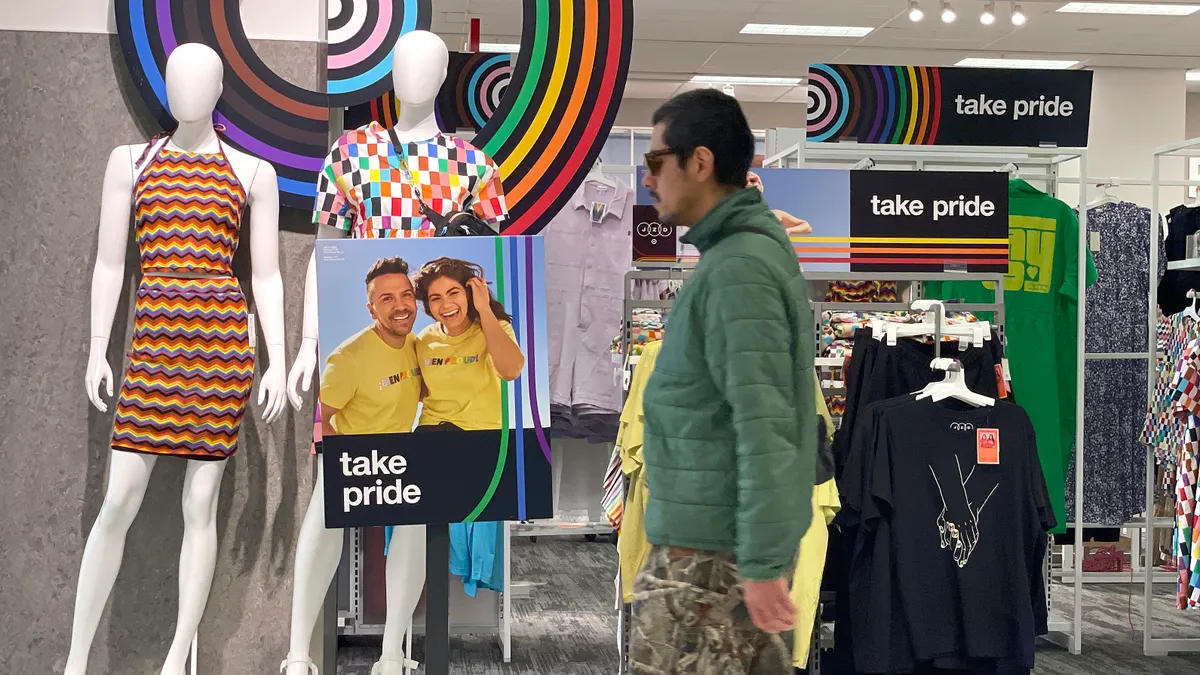Purpose-driven marketing came under fire in 2023, with controversies roiling high-profile brands for months on end. The outcry, which extended beyond online kerfuffles to actually dent sales and revenue, has sent a chilling effect across an industry already contending with economic constraints. While the case for purpose remains strong, with plenty of research touting the potential benefits to the bottom line, these false steps may be a symptom of a larger underlying problem related to weak brand-building.
CMOs under growing pressure to tie their work to short-term results have spun too far toward performance media, experts said, making their brands’ positioning less defined and resilient against misfires. At the same time, advertisers and agencies alike are contending with the existential threat posed by the rise of generative artificial intelligence, which could make the lack of distinct brand identities more of a liability. Marketers have spent much of 2023 wondering whether their jobs are imperiled by automation, but purpose carries a degree of complexity and nuance that could still require the human touch to pull off.
“The importance of purpose-led marketing has probably never been greater,” said Margot Acton, a managing partner specializing in brand strategy at Kantar. “Algorithms are finding people. If you’re not a brand that snaps to my mind as important and meaningfully different in ways that I care about, then you’re actually going to be in trouble.”
As the U.S. heads into another contentious election cycle and inflation is slow to cool, brand-building will be tested by a walking-on-eggshells environment, with purpose one of the most vulnerable tactics amid crusades against “wokeness.” Purpose has flexible definitions but is generally understood as the values a brand stands for beyond making money, such as protecting the environment or diversity, equity and inclusion.
More of the hard work for those causes may happen behind the scenes instead of manifesting in buzzword-heavy ad campaigns, speaking to how purpose needs to be a function that touches all aspects of the C-suite, not just the CMO. The close of 2023 could also serve as a point of reflection for marketers who eagerly jumped on the purpose bandwagon without a readiness to commit to a cause for the long haul, alienating consumers on several fronts.
“Some of the basic tenets and premises got forgotten,” said Rosemarie Ryan, co-founder and CEO at Co:Collective, a strategy consultancy focused on helping businesses implement purpose. “There’s been some damage that’s been done.”
A perfect storm
A confluence of factors tripped up purpose-led marketing initiatives and ultimately led to weaker brand-building output this year. The economy remains mired in uncertainty, making marketers more beholden to quarterly performance measures. Backing up work that gets criticized is a tall ask for CMOs who may fear their jobs are at risk on the off chance that a single campaign element becomes a hot-button national discussion.
“When you can say kiss my ass, you can say kiss my ass,” said Brandon Rochon, head of creative at independent ad agency Hothouse. “Right now, you can’t.”
Underpinning the unease are heightened political divisions, which rarely cooled from the last two election cycles and are again running high heading into 2024. Online safeguards and civility feel in crisis in a fragile moment. X, formerly known as Twitter, has reportedly seen an uptick in hate speech under loosened moderation rules mandated by Elon Musk. Musk himself has been under fire since acquiring the platform last year, most recently for expressing support for antisemitic conspiracy theories.
“When things blow up, the data gets buried. We look at the immediate reaction and not the longer-term implications.”

Rosemarie Ryan
Co-Founder and CEO, Co:Collective
But the toxicity is hardly localized to X and disinformation continues to spread across social media, amplified by rising concerns around AI and deepfakes. Meanwhile, premium publishers have struggled, if not outright shuttered, in a weakened ad market. Marketers have tried to keep their campaigns away from contentious topics, including abortion and climate change, under the guise of brand safety but undercut authentic news and analysis in the process.
In this fractured environment, purpose has become a punching bag easily linked to corporate cynicism and anti-woke campaigns, a culture war sticking point that caught Bud Light off-guard last spring. Boycotts following a partnership with transgender influencer Dylan Mulvaney contributed to the brand losing its long-held spot as America’s top-selling beer, while Benoit Garbe, U.S. CMO at parent company Anheuser-Busch InBev, resigned in November. Anheuser-Busch InBev saw U.S. revenue dip 13.5% in Q3, a sign that the blowback continues to dog its business. Advertisers will enter 2024 with the fear that they could be caught blindsided in a similar manner for something that may, on paper, seem innocuous.
“Brands are increasingly aware of the effort and strategic energy required to get it right,” said Acton. “There’s a pretty determined effort against what success looks like.”
Even companies that developed a reputation for linking purpose with brand-building are pivoting beneath a mix of mounting investor pressure, shifting consumer tastes and public skepticism. Unilever helped lead the charge for discussions around sustainability and body positivity in the consumer packaged goods category. But the Dove and Hellmann’s marketer, which is in the midst of a leadership transition, has acknowledged that its efforts have been unfocused of late and indicated that not every brand in its sprawling portfolio needs to be built around purpose.
“Our focus on purpose is laudable, and it inspires many people to join and stay with Unilever, so we must never lose it,” said Unilever’s new CEO Hein Schumacher during a recent trading update. “But I don’t think we advance the cause of purpose by force-fitting it across every brand.”
Off-balance
Marketers are at least somewhat to blame for the purpose backlash, according to branding experts. Too many jumped into the space because it was in vogue to do so, only to backpedal or go silent in the current rough patch. Others rested on their laurels without conducting the hygiene needed to recognize that what worked in 2016 or 2019 wouldn’t play as well 2023.
“There’s a pretty determined effort against what success looks like.”

Margot Acton
Managing partner, brand strategy, Kantar
A lack of internal alignment around what purpose means and who oversees purpose-led initiatives was widely cited by experts as one of the industry’s biggest stumbling blocks. CMOs have frequently been the public faces behind purpose but all members of the C-suite should be involved to prevent communication breakdowns.
“Bad execution gives anybody the ability to poke holes in you,” said Acton. “It’s the bad execution that’s the problem, not the determination to stand for something important.”
Beyond messaging missteps, marketers have also over-prioritized performance media that does not lend brands a distinctive voice, according to strategists. Retail media is one of the biggest magnets for packaged goods spending at the moment but is mostly centered on sponsored product listing and display ads that are designed to encourage transactions. Companies that have an entrenched image with consumers, such as Apple or Nike, may be able to more easily brush off controversy thanks to the strengths of their brands and a degree of creative vibrancy, according to Hothouse’s Rochon. The pendulum may need to swing back toward brand-building if CMOs want to safeguard against today’s marketing pitfalls, purpose-related or not.
“You can only push the lower funnel for so long,” said Kantar’s Acton of performance marketing. “You take your foot off the gas in terms of what the brand means and stands for, and the price of pushing the lower funnel goes up higher and higher.
“That’s the balance that a lot of marketers are quite worried about. But they operate in organizations with very short-term goals,” added Acton.
Widening ideological chasm
A wishy-washy approach to purpose and flagging brand-building have driven sharp responses from political factions on both ends of the spectrum, with some people fanning the flames of outrage and others feeling let down by brands they once viewed as allies. The latter case stung Target, which backed off some of its Pride Month promotions last summer in a move executives argued was meant to address employee safety but nevertheless upset pockets of the LGBTQ community. Responses on the /r/Target subreddit, which includes employees, underline the sense of betrayal, with several users perceiving the retailer as caving to bullies and setting a worrying precedent.
Looking past activist cohorts, it’s possible brands have underestimated the general state of consumer weariness and how that could affect the response to bold brand-building plays. Under one-third of surveyed U.S. adults (29%) across age brackets believe corporations should use their power to affect political and social issues, according to Morning Consult research. That figure is higher than before the pandemic but lower than 2020 findings, though the disparities between demographic breakouts are widening in noteworthy ways.
“The U.S. public’s appetite for corporate advocacy on political and cultural issues is similar to where it was during the 2020 presidential election,” the Morning Consult report said. “But there is a generational and ideological chasm opening, with Gen Z adults, millennials and Democrats on one side and Gen Xers, baby boomers and Republicans on the other.”
Despite a set of steep challenges, purpose will remain in the marketing discussion for the foreseeable future. Morning Consult’s insights around Gen Z and millennials emphasize why: Forty-one percent of surveyed members of those groups are in favor of brand activism, up from 27% in 2019. Young cohorts carry especially strong sentiments about corporations speaking out about climate change, workplace diversity and racial issues in the U.S., the latter subject having the widest gap in support between Gen Z and millennials and their older counterparts.
A brand position addressing tangible problems — assuming it’s backed up by evidence and action — might resonate as discerning the real from the artificial becomes more difficult in 2024. Companies also need to reckon with the fact that the shouting matches that have animated backlash in 2023 are likely to persist. Pumping the brakes on purpose — and the continued gravitation away from longer-term brand-building work — might make sense when it comes to short-term thinking but potentially carries an existential risk.
“When things blow up, the data gets buried. We look at the immediate reaction and not the longer-term implications,” said Ryan. “Whether they like it or not, companies are being pulled further and further into these conversations. That isn’t going to go away.”























